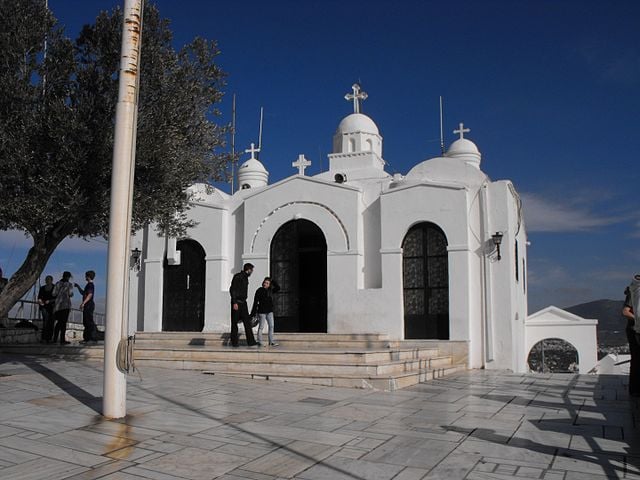

Located in the heart of Athens, Mount Lycabettus provides a serene, picturesque escape from the noise and hubbub of Greece’s capital.
At the highest elevation in all of hilly Athens, Mt. Lycabettus provides stunning views that stretch from the Athenian Riviera along the Saronic Gulf all the way to the mountains that surround the Greek capital.
The easy hike up to the top of the hill begins at the base of the mountain, located near the chic Athenian neighborhood of Kolonaki. If you’re not up for the jaunt, you can use a funicular to reach the top which runs about every half hour.
You can start from Plateia Dexamenis, or Dexameni Square, where you can stop for a coffee or juice before you start your journey to the summit of the hill.
The way up to the top of Lycabettus is lined with lush trees and countless fruit-bearing cacti, which provide a welcome green oasis in the center of Athens.

Once at the top, visitors can marvel at the stunning, unique panoramic view of the city, featuring the Acropolis and the Parthenon, the port of Piraeus, the mountains surrounding the city, and even the island of Aegina on a clear day.
Those with some knowledge of the city can easily point out specific neighborhoods and landmarks from the summit, including Syntagma Square and Plaka.

The small, white-washed church dedicated to St. George, built in the nineteenth century, is located at the very summit of the hill. Inside the picturesque church are important paintings and religious artifacts dating back hundreds of years.
Visitors can also stop at the restaurant close by, which boasts the best views of the city, for a meal, cocktail, or that essential Greek coffee.
Mount Lycabettus is a particularly popular destination in the evening during the summer when the sunset blankets the city in warm tones of orange, purple, and pink, but it provides beautiful views at any time of the day and at every season.

Visitors and residents of Athens throughout history have commented on the hill’s interesting shape and placement in the city, as though it had been dropped there just for the purpose of providing panoramic views of the city’s many landmarks.
According to Greek mythology, the goddess Athena, after receiving bad news, dropped a large chunk of limestone in the middle of Athens while constructing the Acropolis, thus creating Mount Lycabettus.
Although the etymology of the hill’s name is contested, the most likely explanation is thought to stem from the Greek work lykos, or wolf, as wolves were thought to have roamed the hill during ancient times. This is at least the theory that Hesychius of Alexandria proposed.
Hesychius was a Greek grammarian who, probably in the 5th or 6th century AD, compiled the richest lexicon of unusual and obscure Greek words that has survived, probably by absorbing the works of earlier lexicographers.
Although there are no longer any wolves on the hill, Mount Lycabettus is still a natural escape amidst the bustle of modern Athens.
